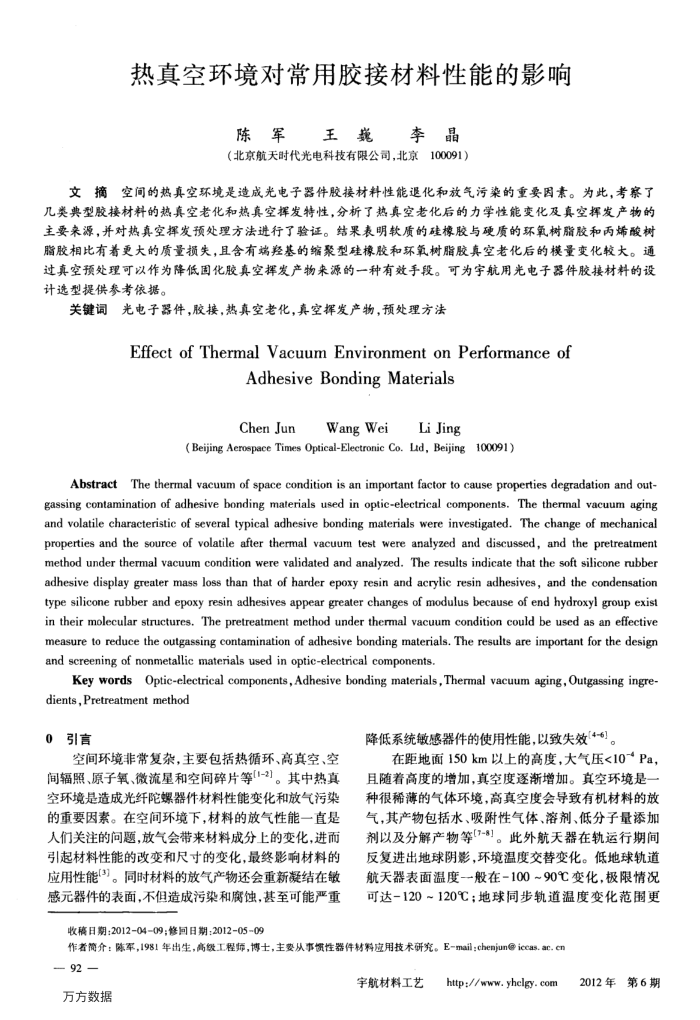您当前的位置:首页>论文资料>热真空环境对常用胶接材料性能的影响
内容简介
 热真空环境对常用胶接材料性能的影响
热真空环境对常用胶接材料性能的影响陈军王巍李晶(北京航天时代光电科技有限公司,北京100091)
文摘空间的热真空环境是造成光电子器件胶接材料性能退化和放气污染的重要因素。为此,考察了
儿类典型胶接材料的热真空老化和热真空挥发特性,分析了热真空老化后的力学性能变化及真空挥发产物的主要来源,并对热真空挥发预处理方法进行了验证。结果表明软质的硅橡胶与硬质的环氧树脂胶和丙烯酸树脂胶相比有着更大的质量损失,且含有端羟基的缩聚型硅橡胶和环氧树脂胶真空老化后的模量变化较大。通过真空预处理可以作为降低固化胶真空挥发产物来源的一种有效手段。可为宇航用光电子器件胶接材料的设计选型提供参考依据。
关键词光电子器件,胶接,热真空老化,真空挥发产物,预处理方法
EffectofThermalVacuumEnvironmentonPerformanceof
AdhesiveBondingMaterials
Chen Jun
WangWeiLi Jing
(Beijing Aerospace Times Optical-Electronic Co. Lid, Beijing 100091)
AbstractThe thermal vacuum of space condition is an important factor to cause properties degradation and out-gassing contamination of adhesive bonding materials used in optic-electrical components.The thermal vacuum aging and volatile characteristic of several typical adhesive bonding materials were investigated. The change of mechanical properties and the source of volatile after thermal vacuum test were analyzed and discussed, and the pretreatment method under thermal vacuum condition were validated and analyzed. The results indicate that the soft silicone rubber adhesive display greater mass loss than that of harder epoxy resin and acrylic resin adhesives, and the condensation type silicone rubber and epoxy resin adhesives appear greater changes of modulus because of end hydroxyl group exist in their molecular structures.The pretreatment method under thermal vacuum condition could be used as an effective measure to reduce the outgassing contamination of adhesive bonding materials.The results are important for the design and screening of nonmetallic materials used in optic-electrical components.
Key wordsOptic-electrical components,Adhesive bonding materials,Thermal vacuum aging,Outgassing ingre-dients,Pretreatment method
0引言
空间环境非常复杂,主要包括热循环、高真空、空间辐照、原子氧、微流星和空间碎片等(1-2]。其中热真空环境是造成光纤陀螺器件材料性能变化和放气污染的重要因素。在空间环境下,材料的放气性能一直是人们关注的问题,放气会带来材料成分上的变化,进而引起材料性能的改变和尺寸的变化,最终影响材料的应用性能(3)。同时材料的放气产物还会重新凝结在敏感元器件的表面,不但造成污染和腐蚀,甚至可能严重
收稿日期:201204-09;修回日期:2012-05-09
降低系统敏感器件的使用性能,以致失效[4-6]
在距地面150km以上的高度,大气压<10-Pa,且随着高度的增加,真空度逐渐增加。真空环境是一种很稀薄的气体环境,高真空度会导致有机材料的放气,其产物包括水、吸附性气体、溶剂、低分子量添加剂以及分解产物等(7-8]。此外航天器在轨运行期间反复进出地球阴影,环境温度交替变化。低地球轨道航天器表面温度-般在-100~90℃变化,极限情况可达-120~120℃;地球同步轨道温度变化范围更
作者简介:陈军,1981年出生,高级工程师,博士,主要从事惯性器件材料应用技术研究。E-mail:chenjun@iceas.ac.cn
—92-万方数据
宇航材料工艺
http://www.yhclgy.com
2012年第6期